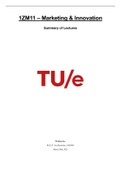1ZM11 – Marketing & Innovation
Summary of Lectures
Written by:
R.F.J.F. Van Doorslaer, 1001804
March 30th, 2023
, Session 1 – Customer Value
Date: 2023-02-07
Articles: Gourville (2006)
Woodruff (1997)
Key Terms: Means-end chain, customers’ loss aversion; value -in-use
The 1st Problem: Identifying Value and Convincing Customers
Companies often struggle to convince customers to buy their new, innovative products, showing that customer
value is something ambiguous.
Innovations are often trade-offs: they bring something new but underperform in another dimension. E.g., an
electric car ensures a cleaner environment, but lacks easy refueling.
This is why customers value innovations differently than the companies do.
The 2nd Problem: Eliminating Value to Increasing Profit
There is a trend where companies eliminate value to increase profits. As a result, loyal customers can spiral
down the order, or may be lost altogether.
Figure 1: The Death Spiral
What is value?
Woodruff (1997) puts together different definitions for customer value:
- “Value is low price”
- “Value is whatever I want in a product” → utility
- “Value is the quality I get for the price I pay” → trade-off
- “Value is what I get for what I give” → trade-off
Value is thus defined as benefits – costs. The larger this value, the more attractive the offering is. The same
holds for a B2B context.
2
, Figure 2: Customer Value
Woodruff (1997) continues this concept, and states that value depends on:
- Product attributes
- Attribute performances
- Consequences, arising from use that facilitate (or block) achieving goals and purposes.
Customer Value Determination Process
Firms should follow what customers value and find important, and then whether this value is delivered to
customers. This is not about what customers value today, but tomorrow!
There are several methods to understand customer value:
- Customer need research (e.g., Lead User Analysis, Customer Cocreation)
- Trade-off analysis (Conjoint Analysis)
- Means-End Chain Analysis / Benefits Sought (Laddering)
These act as input for (benefit) segmentation analysis.
Theory: Means-End Chain
This is a psychological perspective for how people relate to products. Based on a product’s salient (= most
noticeable / important) attributes, they will estimate the benefits they get (functional and psycho-social), which
help them achieve values in life (instrumental or terminal). This also holds for a B2B context.
Figure 3: Means-End Chain
3
, Terminal values (a happy life, love, security) can be achieved with instrumental values (clean, helpful,
logical).
Customer Value Learning
Firms should create a customer value delivery strategy, which is translated into internal customer value
processes and requirements (Quality Function Deployment, simulations, customer use scenario exercises).
Implementing customer value delivery may require organizational changes, and its performance can be
tracked using satisfaction or perceptual mapping.
New Value Opportunities: CSR
The concept of Corporate Social Responsibility (CSR) is a new value opportunity. It is usually difficult to
create extra profit out of this. The fact that it is becoming more mainstream makes it even harder to leverage.
Literature proposes different frameworks to help manage CSR. This framework states that perceptions of CSR
should be managed to make stakeholders see the benefits and enjoy values. This should improve outcomes and
attitudes.
Figure 4: Framework to help manage CSR.
Co-creation
Co-creation has a more direct link with customer value, as customers help create value (think of Lego). The
same holds for collaborative consumption platforms.
Value-in-use
Value must be experiences in the context of the user, so not just the perception. Can the user get all the value out
of the product? In a study by Macdonald et al., it was shown that resources need to be integrated from supplier
and customer resources. This unleashes a collective value-in-use (IMPORTANT).
4





